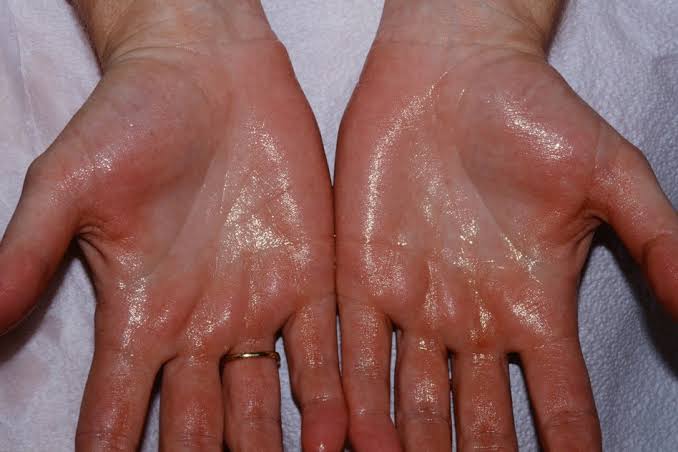Hyperhidrosis Treatment in Nigeria (Excessive Sweating Treatment) – Botox, antiperspirants (drysol), surgery, drugs, and miradry.
It ia well known that people sweat when they exercise or exert themselves or are in a hot environment or maybe due to stress. But the people who have Hyperhidrosis experience excessive sweating which is not necessarily due to the rise in temperature or exercise. This condition could lead to social anxiety and embarrassment. This sweats soaks their clothes and could cause body odour.
At least 350 million people worldwide have hyperhidrosis.

Parts of body most affected by hyperhidrosis
Excessive sweating may affect your:
💥hands (Palmer hyperhidrosis),
💥feet (Planter hyperhidrosis)
💥scalp, head and face (Craniofacial hyperhidrosis).
💥Groin
Symptoms:
➡️Frequent sweating.
➡️Noticeable sweating that soaks through clothing.
➡️Clammy or wet palms of hands and soles of the feet.
➡️Underlying other medical conditions like diabetes, infections, low blood sugar(hypoglycemia), cancer, and many more.
When to seek medical attention?
➡️If sweating disrupts the daily routine.
➡️If sweating causes emotional distress and embarrassment.
➡️If suddenly sweating increases.
➡️If someone experiences night sweats for no apparent reason.
Treatment of excessive sweeting (hyperhidrosis)
1. Antiperspirants
There are several ways to treat mild hyperhidrosis using antiperspirant, wipes and creams. A popular antiperspirant in Nigeria right now is drysol,it contains 20% Aluminum Chloride and anhydrous ethyl alcohol.
It is mostly used to treat excessive underarm sweating and palmar hyperhidrosis. However, when combatting excessive sweating, most of these over-the-counter (OTC) antiperspirants are ineffective. Their commonest side effect is skin irritation.
2. Oral medications
There are some oral medications which can be prescribed to reduce sweating. Most belong to a group of drugs called anticholinergics and work by blocking a chemical called acetylcholine which the nervous system uses to activate our sweat glands. These include medicines such as: glycopyrrolate, oxybutynin, benztropine, propantheline, and others.
Many hyperhidrosis patients experience success with anticholinergic therapy. The drawback to these oral medications is that they work on the body as a whole so have a number of side effects, including dry mouth, constipation and can cause problems urinating, so most patients only use them for short-term relief.
3. BOTOX injections
One of the most effective treatments, which is FDA approved is the administration of botox injections. In fact, Hyperhidrosis treatment with botolinium injections are proven to reduce sweating by 87%.
The Botox injections are effective in controlling excessive sweating of the scalp, palms, soles, underarms (armpits) etc. Botox works by relaxing overactive nerves responsibe for activating excess sweat glands.
The results can be found almost immediately after the treatment. Though very effective, the effects of botox are short-lived. This form of treatment is also very expensive.
4. Surgery
This is an invasive treatment for excessive sweating and it has its complications. Endoscopic thoracic sympathectomy or ETS is the most common type of hyperhidrosis surgery and involves the nerves that control sweating being cut or clipped under a general anaesthetic.
Deciding to have ETS surgery is a significant step though as it carries a risk of serious complications and can cause people to excessively sweat elsewhere in the body and isn’t always 100% successful. The side effects make surgical treatment for hyperhydrosis unpopular.
5. MIRADRY
Newest treatment for excessive sweating that is said to be 82 percent effective. It is also a form of surgical treatment but it is less invasive and the side effects are very minimal. It sort of “microwaves” the sweating area. Miradry is still being studied and now gaining popularity in Nigeria.
Sources:
Advanced Cosmetic
Consulting Room
Featured Image: The Logical Indian





















